Blog
Why Does Cheese Go Moldy?
You may be wondering, why does cheese go moldy? Cheese lovers all over the world have been asking the same question.
In this article, we delve into the science behind why cheese goes moldy and shed light on the factors that contribute to this natural occurrence.
Understanding the Nature of Cheese Mold
Mold is a type of fungus that thrives in warm and moist environments. When it comes to cheese, mold growth can occur due to a combination of factors. These include the presence of mold spores in the air, moisture content, temperature, and the type of cheese.

The Role of Mold Spores
Mold spores are microscopic particles that are present in the environment. They can be found in the air, on surfaces, and even on the cheese itself. When conditions are favorable, these spores can settle on the cheese’s surface and begin to grow. This, in turn, leads to the formation of visible mold.
Moisture Content and Cheese Storage
The moisture content of cheese plays a crucial role in its susceptibility to mold growth. Soft and moist cheeses, such as blue cheese and Camembert, have higher water content and are more prone to mold development. Proper storage is essential to prevent excessive moisture buildup.
Cheese should be wrapped in breathable materials like wax paper or cheese paper to maintain a moisture balance. This will also help prevent mold growth while allowing the cheese to mature.
Temperature and Cheese Preservation
Temperature is another critical factor in cheese preservation. Most cheeses should be stored at cool temperatures to slow down the growth of mold and other spoilage organisms. However, certain types of cheese, such as blue cheese, require specific temperature conditions to develop their characteristic mold veins.
Understanding the optimal storage temperature for each type of cheese is key to preserving its quality and preventing unwanted mold growth.
Cheese Rind and Mold
The rind, or outer layer, of some cheeses, acts as a protective barrier against mold. Cheeses like Brie and Camembert have bloomy rinds that form a layer of white mold.
This mold is intentionally introduced during the cheese-making process and contributes to the unique flavors and textures of these cheeses. However, it’s important to note that not all mold growth on cheese rinds is desirable. Unwanted mold can indicate improper storage conditions or a deterioration in the cheese’s quality.
Preventive Measures and Moldy Cheese
While mold growth is a natural occurrence in some types of cheese, it’s understandable that many people prefer to avoid consuming moldy cheese.
To prevent mold growth, it’s crucial to handle and store cheese properly. Keep cheese refrigerated, wrapped in breathable materials or in a suitable container. Keep cheese separate from other foods to minimize the risk of cross-contamination. Additionally, inspect cheese regularly. Discard any portions with visible mold growth or unpleasant odors.
Wrapping It Up
Understanding why cheese goes moldy helps us appreciate the complex interplay of environmental factors, moisture content, temperature, and cheese type.
While mold growth is a natural process in some cheeses and even intentional in others, it can still be off-putting to find mold in our favorite varieties.
By following proper storage and handling practices, we can extend the shelf life of cheese and minimize the risk of unwanted mold growth.
So, next time you encounter mold on your cheese, remember that it’s simply a natural part of the cheese maturing process.




